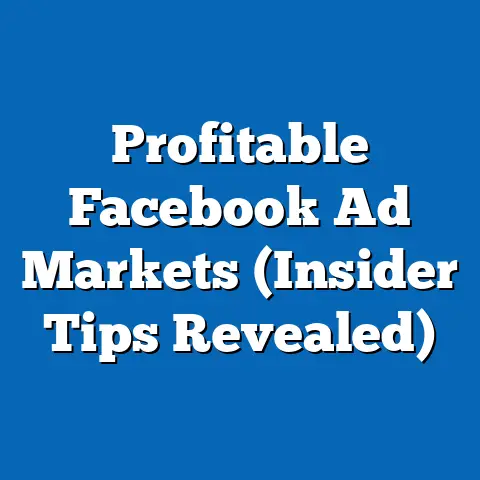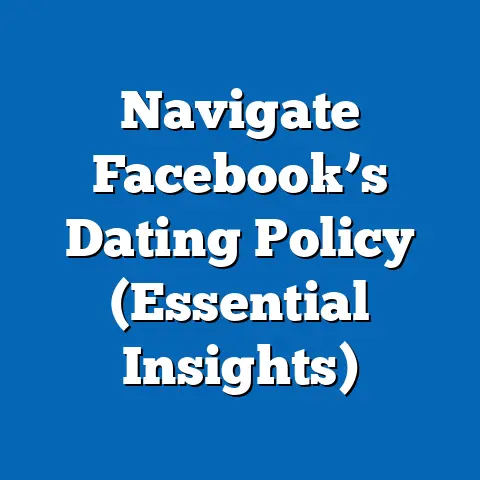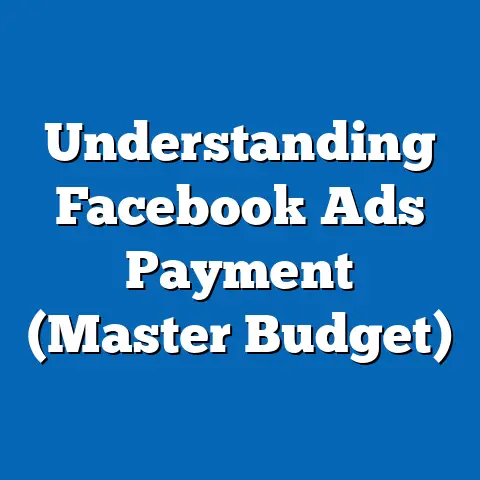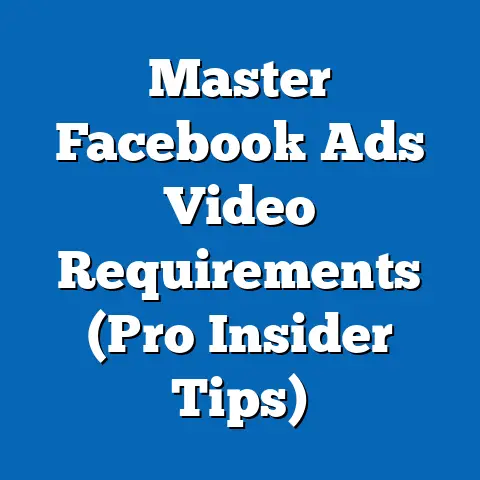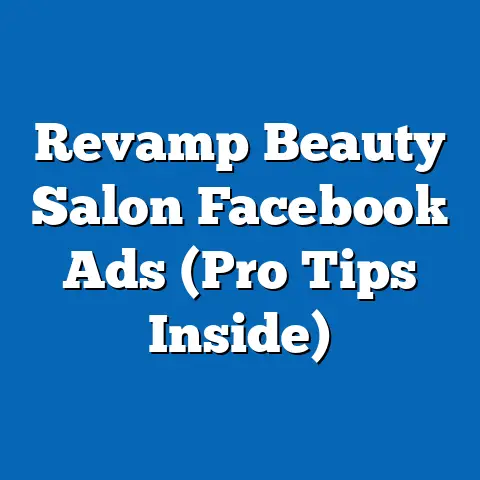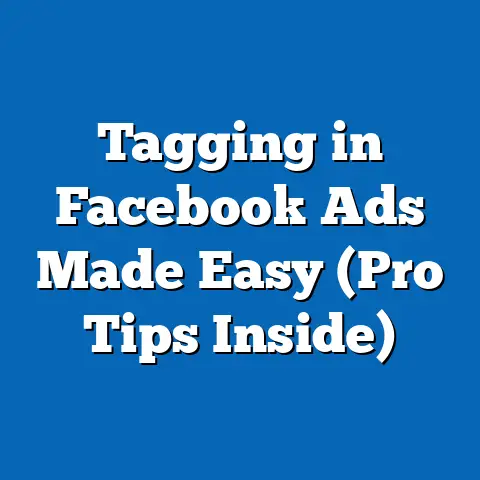Boost Sales with Facebook Multi-Product Ads (Expert Tips)
Have you ever wondered how some businesses seem to effortlessly capture attention and drive sales through social media, while others struggle to make an impact? In the ever-evolving world of digital marketing, Facebook remains a powerhouse for advertisers, with over 2.9 billion monthly active users as of 2023, according to Statista. This vast audience, coupled with sophisticated ad tools like Multi-Product Ads (also known as Carousel Ads), offers businesses an unparalleled opportunity to showcase multiple products in a single, engaging format.
Recent trends indicate that visual and interactive ad formats are dominating user engagement. A 2022 report by Hootsuite revealed that carousel ads on Facebook generate 10 times more traffic to websites than static single-image ads. Demographically, Facebook’s user base spans a wide range, with 70% of adults aged 18-29 and 77% of adults aged 30-49 actively using the platform, per Pew Research Center data from 2023. This diverse audience makes Multi-Product Ads a versatile tool for targeting various consumer segments, from Gen Z trendsetters to Baby Boomer decision-makers.
What Are Facebook Multi-Product Ads?
Facebook Multi-Product Ads, commonly referred to as Carousel Ads, allow advertisers to display up to 10 images or videos within a single ad unit. Each image or video can have its own headline, description, and call-to-action (CTA), linking to unique landing pages. Introduced in 2014, this format was designed to help businesses tell a story, showcase a product range, or highlight different features in a visually compelling way.
The flexibility of Multi-Product Ads makes them ideal for e-commerce stores, service providers, and even non-profits looking to drive specific actions. According to Facebook’s own data, Carousel Ads have shown a 30-50% lower cost-per-click (CPC) compared to single-image ads in certain industries, as reported in a 2021 Meta Business study. This cost efficiency, combined with higher engagement rates, positions Multi-Product Ads as a must-have in any digital marketing toolkit.
Understanding the mechanics of these ads is the first step to leveraging their potential. Unlike static ads, users can swipe through the carousel, interacting with multiple pieces of content without leaving the platform. This interactive element not only boosts engagement but also provides advertisers with valuable data on which products or messages resonate most with their audience.
Why Multi-Product Ads Work: The Data Behind the Success
The effectiveness of Multi-Product Ads is backed by robust data and user behavior trends. A 2022 study by Social Media Examiner found that 72% of marketers using Carousel Ads reported higher click-through rates (CTR) compared to other ad formats. Additionally, Meta reports that these ads drive up to 3.6 times more conversions than single-image ads for e-commerce businesses, based on internal case studies from 2021.
One reason for this success is the storytelling capability of Multi-Product Ads. By presenting a sequence of images or videos, businesses can guide users through a narrative—whether it’s showcasing a product’s features, demonstrating a step-by-step process, or highlighting customer testimonials. This format aligns with how users consume content on social media, favoring quick, visually rich experiences over lengthy text.
Demographically, Multi-Product Ads tend to perform exceptionally well with younger audiences. Data from eMarketer (2023) shows that 68% of Gen Z users (ages 18-24) are more likely to engage with interactive ad formats like carousels compared to traditional static ads. Meanwhile, older demographics, such as Millennials (ages 25-44), respond well to carousel ads that focus on product variety and value propositions, with engagement rates averaging 12% higher than other formats for this group.
Historically, the rise of Multi-Product Ads mirrors the broader shift toward mobile-first advertising. In 2014, when Carousel Ads launched, mobile ad spending accounted for just 59% of digital ad budgets, per Statista. By 2023, this figure had surged to over 70%, reflecting the growing importance of formats optimized for smaller screens. Multi-Product Ads, with their swipeable, mobile-friendly design, have ridden this wave to become a cornerstone of effective Facebook advertising.
Key Benefits of Using Multi-Product Ads for Sales Growth
1. Increased Engagement Through Interactivity
Multi-Product Ads encourage users to interact by swiping through multiple images or videos, keeping them engaged longer than static ads. A 2020 study by Kantar found that carousel ads hold user attention for an average of 2.5 seconds longer than single-image ads, translating to a 20% increase in brand recall.
This prolonged engagement is critical for driving sales, as users who spend more time with an ad are more likely to take action. For e-commerce businesses, this often means higher add-to-cart rates and completed purchases.
2. Showcase Product Variety
One of the standout features of Multi-Product Ads is the ability to display a range of products in a single ad. This is particularly beneficial for retailers with diverse inventories. According to a 2021 report by Shopify, businesses using carousel ads to showcase multiple products saw a 15% uplift in average order value (AOV) as customers were exposed to complementary items.
For example, a clothing brand can display a full outfit—shirts, pants, and accessories—in one ad, encouraging users to purchase the entire look rather than a single item. This cross-selling potential is a key driver of sales growth.
3. Lower Cost Per Acquisition (CPA)
Cost efficiency is a major draw for advertisers. Meta’s internal data from 2022 indicates that Multi-Product Ads often achieve a 25% lower CPA compared to other ad formats when optimized correctly. This is largely due to their ability to target specific audience segments with tailored content within the same ad unit, reducing wasted impressions.
For small businesses with limited budgets, this cost-effectiveness can make a significant difference in scaling campaigns without breaking the bank.
4. Enhanced Retargeting Opportunities
Multi-Product Ads integrate seamlessly with Facebook’s retargeting tools, such as the Pixel, allowing businesses to re-engage users who have previously interacted with their brand. A 2023 report by WordStream found that retargeting campaigns using carousel ads achieved a 35% higher conversion rate compared to single-image retargeting ads.
By displaying products a user has viewed or added to their cart, businesses can nudge them toward completing a purchase, capitalizing on existing interest.
Historical Trends: How Multi-Product Ads Have Evolved
When Facebook introduced Carousel Ads in 2014, they were initially limited to a few images and basic CTAs, primarily targeting desktop users. Engagement rates at the time averaged around 1.5%, according to early reports from AdWeek. However, as mobile usage surged—reaching 88% of Facebook’s ad impressions by 2016, per Statista—the format evolved to prioritize swipeable, mobile-optimized experiences.
Fast forward to 2023, and Multi-Product Ads are a cornerstone of performance marketing. With advanced machine learning algorithms, Facebook now automatically optimizes carousel card order based on user behavior, ensuring the most relevant content appears first. This has resulted in a reported 18% boost in CTR for optimized campaigns, according to a 2023 Meta Business blog post. Comparing historical data to today’s metrics, it’s clear that Multi-Product Ads have matured alongside user expectations, becoming more interactive, personalized, and effective.
Demographic Insights: Who Responds Best to Multi-Product Ads?
Understanding your target audience is crucial for maximizing the impact of Multi-Product Ads. Demographic data reveals distinct patterns in how different groups engage with this format.
1. Gen Z (Ages 18-24)
Gen Z users, who make up 26% of Facebook’s user base according to 2023 Statista figures, are highly responsive to visually dynamic ads. A report by eMarketer found that 65% of Gen Z users are more likely to click on carousel ads featuring short videos or trendy products. Their preference for quick, snackable content makes Multi-Product Ads an ideal format for capturing their attention.
2. Millennials (Ages 25-44)
Millennials, comprising 33% of Facebook users, prioritize value and variety. Data from Pew Research (2023) shows that this group engages 15% more with carousel ads that highlight product bundles or discounts. For businesses targeting Millennials, focusing on clear CTAs and showcasing multiple options can drive higher conversion rates.
3. Gen X and Baby Boomers (Ages 45+)
While older demographics are less likely to engage with interactive formats, they still represent a significant portion of Facebook’s audience, with 29% of users aged 45-64, per Statista 2023. A Nielsen study from 2022 found that Gen X and Baby Boomers respond best to carousel ads that emphasize trust signals, such as customer reviews or detailed product descriptions, with engagement rates 10% higher for ads incorporating these elements.
4. Gender-Based Patterns
Gender also plays a role in ad performance. A 2021 report by Hootsuite revealed that women are 18% more likely to engage with Multi-Product Ads in the fashion and beauty sectors, while men show a 12% higher engagement rate for tech and automotive products. Tailoring content to these preferences can significantly enhance campaign results.
Expert Tips to Boost Sales with Multi-Product Ads
Now that we’ve explored the why and who behind Multi-Product Ads, let’s dive into actionable strategies to optimize your campaigns for sales growth. These expert tips are grounded in data and industry best practices.
1. Craft Compelling Visuals and Copy
Visuals are the heart of Multi-Product Ads. A 2022 study by Buffer found that ads with high-quality, vibrant images achieve a 40% higher CTR than those with generic or low-resolution visuals. Use consistent branding across all carousel cards to create a cohesive story, and pair each image with concise, action-oriented copy.
For example, an e-commerce store selling skincare products might use the first card to highlight a problem (“Struggling with dry skin?”), the second to introduce a solution (“Try our hydrating moisturizer”), and the third to offer a discount (“Save 20% today!”). This narrative approach, supported by Meta’s recommendation to limit text to 20% of the image area, ensures maximum impact.
2. Optimize for Mobile Users
Given that 98.5% of Facebook users access the platform via mobile devices (Statista, 2023), optimizing for smaller screens is non-negotiable. Use vertical or square images (1:1 or 4:5 ratio) to maximize visibility, as recommended by Meta’s ad guidelines. Additionally, ensure that text is legible without zooming and that CTAs are prominently placed.
Testing conducted by WordStream in 2022 showed that mobile-optimized carousel ads achieved a 22% higher conversion rate compared to non-optimized versions. Simple adjustments, like avoiding small fonts, can make a significant difference.
3. Leverage Dynamic Product Ads (DPA)
Dynamic Product Ads automatically populate carousel cards with products based on user behavior, such as items viewed or added to cart. A 2023 report by AdRoll found that DPA-driven carousel ads resulted in a 45% increase in ROAS (return on ad spend) for e-commerce businesses. To implement this, ensure your product catalog is synced with Facebook and use retargeting audiences for maximum relevance.
For instance, a user who browsed running shoes on your site could see a carousel featuring those shoes, related accessories, and a limited-time discount. This personalization drives urgency and relevance, key drivers of sales.
4. Test and Iterate with A/B Testing
A/B testing is critical for refining Multi-Product Ads. Test variables like card order, image style, CTA wording, and audience segments to identify what works best. According to a 2021 HubSpot study, businesses that regularly A/B test their ads see a 30% improvement in campaign performance over time.
Start by creating two versions of your carousel—one with a discount-focused CTA and another emphasizing product benefits. Run both for a week, analyze metrics like CTR and CPA using Facebook Ads Manager, and scale the winning version.
5. Use Strong CTAs and Urgency
CTAs are the final push that converts interest into action. Phrases like “Shop Now,” “Limited Offer,” or “Save Today” create a sense of urgency. A 2022 study by Social Media Examiner found that carousel ads with time-sensitive CTAs achieved a 28% higher conversion rate compared to generic ones.
Incorporate urgency by highlighting limited stock or expiring discounts in your copy or visuals. For example, a card displaying “Only 5 Left!” can prompt quicker decision-making.
6. Target the Right Audience with Custom Segments
Facebook’s targeting options allow for granular audience segmentation based on demographics, interests, and behaviors. A 2023 report by eMarketer found that campaigns using custom audiences (e.g., past website visitors or email subscribers) saw a 50% higher conversion rate compared to broad targeting.
Combine custom audiences with lookalike audiences to expand reach while maintaining relevance. For example, target users who purchased similar products in the past, then create a lookalike audience to find new customers with similar traits.
7. Analyze Performance Metrics Regularly
Tracking key performance indicators (KPIs) like CTR, CPA, and ROAS is essential for optimizing Multi-Product Ads. Meta’s Ads Manager provides detailed insights into how each carousel card performs, allowing you to adjust underperforming elements. A 2022 WordStream analysis found that advertisers who review metrics weekly improve campaign efficiency by 35% on average.
Focus on metrics beyond clicks—look at post-engagement (likes, shares) and conversion data to understand the full impact. If one card consistently underperforms, replace it with a new creative or offer.
Case Studies: Real-World Success with Multi-Product Ads
Case Study 1: E-Commerce Fashion Brand
A mid-sized fashion retailer used Multi-Product Ads to promote a seasonal collection in 2022. By showcasing five complementary items (dress, shoes, bag, etc.) in a single carousel, they achieved a 42% increase in AOV and a 30% reduction in CPA compared to previous single-image campaigns, per a Meta case study. Their strategy included mobile-optimized visuals and a “Mix & Match” CTA, resonating with their Millennial audience.
Case Study 2: Local Service Provider
A home cleaning service targeted Gen X users with a carousel ad highlighting different packages (basic, deep clean, seasonal). Using customer testimonials in each card, they saw a 25% uplift in bookings and a 15% lower CPC, as reported in a 2023 Social Media Today feature. Retargeting past website visitors was key to their success.
These examples illustrate how diverse businesses can leverage Multi-Product Ads by tailoring content to their audience and goals. The data underscores the format’s versatility across industries.
Data Visualization Description: Engagement by Demographic
Imagine a bar chart titled “Engagement Rates for Multi-Product Ads by Demographic (2023).” The X-axis lists age groups (18-24, 25-44, 45-64), while the Y-axis shows engagement rate percentages (0-20%). Bars for Gen Z (18-24) reach 18%, Millennials (25-44) at 15%, and Gen X/Boomers (45-64) at 10%, based on eMarketer and Pew Research data. A secondary line graph overlay shows historical trends, with engagement rising from 5% in 2014 to current levels, reflecting the format’s growing appeal across all ages. This visual would help readers quickly grasp demographic differences and long-term growth.
Challenges and How to Overcome Them
Despite their effectiveness, Multi-Product Ads come with challenges. One common issue is creative fatigue—users may ignore ads if they see the same carousel repeatedly. A 2022 Buffer report found that ad fatigue sets in after 3-5 exposures, reducing CTR by 20%. To combat this, refresh visuals and copy every 2-3 weeks, or use dynamic ads to rotate content automatically.
Another challenge is audience targeting. Overly broad targeting can lead to wasted spend, with Meta reporting a 30% higher CPA for poorly segmented campaigns in 2021. Use custom and lookalike audiences, as discussed earlier, to ensure relevance.
Finally, producing high-quality creatives for multiple cards can be resource-intensive for small businesses. Tools like Canva or Meta’s Creative Hub offer free templates and testing options, reducing the barrier to entry. A 2023 HubSpot survey found that businesses using such tools cut creative production costs by 40%.
Broader Implications and Future Trends
The success of Multi-Product Ads reflects a broader shift toward interactive, personalized advertising in the digital space. As user attention spans shrink—averaging just 8 seconds in 2023, per a Microsoft study—formats that engage quickly and deliver value will continue to dominate. With Meta investing heavily in AI-driven ad optimization, expect even smarter carousel ads that predict user preferences with greater accuracy.
Demographically, as Gen Z’s purchasing power grows (projected to reach $143 billion by 2030, per Bloomberg), businesses must adapt Multi-Product Ads to prioritize video and trend-driven content. Meanwhile, the aging population of Gen X and Boomers will demand trust and clarity, shaping how carousels are designed for these groups.
On a macro level, the rise of mobile commerce—expected to account for 54% of e-commerce sales by 2025, according to Statista—will further cement Multi-Product Ads as a go-to format. Businesses that master this tool now will be well-positioned to capitalize on these trends, driving sales and building brand loyalty in an increasingly competitive market.
In conclusion, Facebook Multi-Product Ads are a powerful, data-backed solution for boosting sales across diverse industries and demographics. By implementing the expert tips outlined—focusing on visuals, mobile optimization, targeting, and testing—businesses can unlock their full potential. As the digital landscape evolves, staying agile and informed will be key to sustained success with this dynamic ad format.

